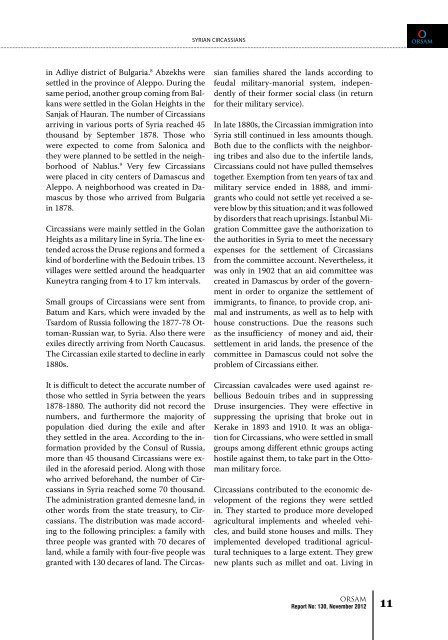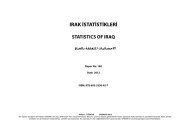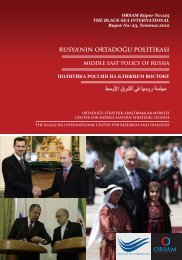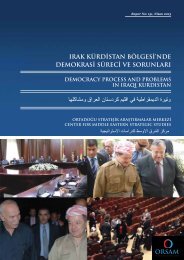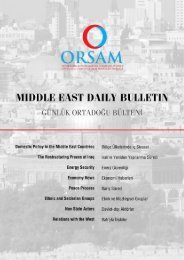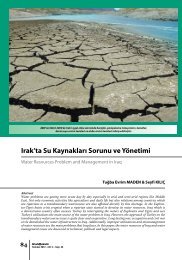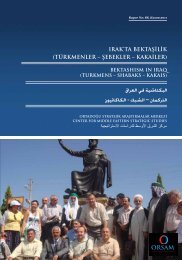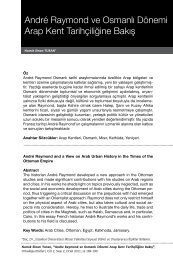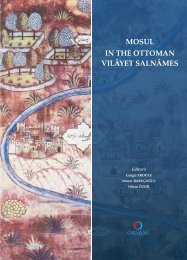SYRIAN CIRCASSIANS - orsam
SYRIAN CIRCASSIANS - orsam
SYRIAN CIRCASSIANS - orsam
Create successful ePaper yourself
Turn your PDF publications into a flip-book with our unique Google optimized e-Paper software.
<strong>SYRIAN</strong> <strong>CIRCASSIANS</strong><br />
ORSAM<br />
in Adliye district of Bulgaria. 8 Abzekhs were<br />
settled in the province of Aleppo. During the<br />
same period, another group coming from Balkans<br />
were settled in the Golan Heights in the<br />
Sanjak of Hauran. The number of Circassians<br />
arriving in various ports of Syria reached 45<br />
thousand by September 1878. Those who<br />
were expected to come from Salonica and<br />
they were planned to be settled in the neighborhood<br />
of Nablus. 9 Very few Circassians<br />
were placed in city centers of Damascus and<br />
Aleppo. A neighborhood was created in Damascus<br />
by those who arrived from Bulgaria<br />
in 1878.<br />
Circassians were mainly settled in the Golan<br />
Heights as a military line in Syria. The line extended<br />
across the Druse regions and formed a<br />
kind of borderline with the Bedouin tribes. 13<br />
villages were settled around the headquarter<br />
Kuneytra ranging from 4 to 17 km intervals.<br />
Small groups of Circassians were sent from<br />
Batum and Kars, which were invaded by the<br />
Tsardom of Russia following the 1877-78 Ottoman-Russian<br />
war, to Syria. Also there were<br />
exiles directly arriving from North Caucasus.<br />
The Circassian exile started to decline in early<br />
1880s.<br />
It is difficult to detect the accurate number of<br />
those who settled in Syria between the years<br />
1878-1880. The authority did not record the<br />
numbers, and furthermore the majority of<br />
population died during the exile and after<br />
they settled in the area. According to the information<br />
provided by the Consul of Russia,<br />
more than 45 thousand Circassians were exiled<br />
in the aforesaid period. Along with those<br />
who arrived beforehand, the number of Circassians<br />
in Syria reached some 70 thousand.<br />
The administration granted demesne land, in<br />
other words from the state treasury, to Circassians.<br />
The distribution was made according<br />
to the following principles: a family with<br />
three people was granted with 70 decares of<br />
land, while a family with four-five people was<br />
granted with 130 decares of land. The Circassian<br />
families shared the lands according to<br />
feudal military-manorial system, independently<br />
of their former social class (in return<br />
for their military service).<br />
In late 1880s, the Circassian immigration into<br />
Syria still continued in less amounts though.<br />
Both due to the conflicts with the neighboring<br />
tribes and also due to the infertile lands,<br />
Circassians could not have pulled themselves<br />
together. Exemption from ten years of tax and<br />
military service ended in 1888, and immigrants<br />
who could not settle yet received a severe<br />
blow by this situation; and it was followed<br />
by disorders that reach uprisings. İstanbul Migration<br />
Committee gave the authorization to<br />
the authorities in Syria to meet the necessary<br />
expenses for the settlement of Circassians<br />
from the committee account. Nevertheless, it<br />
was only in 1902 that an aid committee was<br />
created in Damascus by order of the government<br />
in order to organize the settlement of<br />
immigrants, to finance, to provide crop, animal<br />
and instruments, as well as to help with<br />
house constructions. Due the reasons such<br />
as the insufficiency of money and aid, their<br />
settlement in arid lands, the presence of the<br />
committee in Damascus could not solve the<br />
problem of Circassians either.<br />
Circassian cavalcades were used against rebellious<br />
Bedouin tribes and in suppressing<br />
Druse insurgencies. They were effective in<br />
suppressing the uprising that broke out in<br />
Kerake in 1893 and 1910. It was an obligation<br />
for Circassians, who were settled in small<br />
groups among different ethnic groups acting<br />
hostile against them, to take part in the Ottoman<br />
military force.<br />
Circassians contributed to the economic development<br />
of the regions they were settled<br />
in. They started to produce more developed<br />
agricultural implements and wheeled vehicles,<br />
and build stone houses and mills. They<br />
implemented developed traditional agricultural<br />
techniques to a large extent. They grew<br />
new plants such as millet and oat. Living in<br />
ORSAM<br />
Report No: 130, November 2012 11


